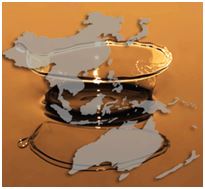Accounting for 44% of the global market, Asia-Pacific is the leading region for finished lubricant demand. Overall finished lubricant demand in the Asia-Pacific region is forecast for modest growth of a CAGR of 1.8% over the next five years. An emphasis on fuel economy and a modern vehicle parc will drive the use of synthetics and other lighter viscosity grade lubricants for passenger car motor oil (PCMO) in the region.
In 2014, the gap between the United States and China for being the #1 largest lubricant-consuming country market continues to shrink. Although passenger car sales growth is expected to slow down in China, penetration is still low compared with developed economies, especially in the middle and inland area, resulting in China still offering potential for long-term growth. The commercial and industrial segments are also expected to recover slightly through 2016, as the government launches several new policies to boost the domestic economy.
Overall competition amongst the major lubricant suppliers has become more competitive in China in recent years, as multinational companies pay more attention to the Chinese market. While major domestic and multinational suppliers used to concentrate on different market sectors, now all include strategies to take market share from other domains.
Following China, India is the third largest country market, accounting for 13% of Asia-Pacific lubricant demand in 2014. After a period of high growth of a common developing country, due to the global and the domestic economic and policy crisis, India has been experiencing a slow down. Recently, marketing campaigns such as Make in India and various infrastructural changes such as the interlinking of rivers, development of 100 smart cities, and Ganga cleaning project among others, if implemented, would add to the overall growth of the economy.
With increased participation of private suppliers, the lubricant industry has seen a falling share of NOCs (IOCL, BPCL, and HPCL). More than 40 small and large suppliers operate in the Indian lubricants market. Competition has increased many-fold, with many new foreign suppliers making inroads either directly or through marketing tie-ups. With a focus either on the quality of products or value proposition, suppliers are either increasing their margins or total sales volumes.
There is a movement towards the use of better quality lubricants, especially engine oil in India as the new fuel efficiency standards finalized by the Bureau of Energy Efficiency (BEE) binding for the car manufacturers are forthcoming in 2017. In the PCMO category, the market will witness a swift movement towards low viscosity engine oils, such as 5W-30/40, whereas in the HDMO category, heavier grades such as 20W-40 and monogrades will be substituted by grades such as 15W-40.
In Thailand, one of the largest Asia-Pacific markets, the total lubricant consumption has declined in 2014 across all three segments. The consumer segment is still the leading segment that also suffered the largest decline due to the flooding in 2011. While the government initiated the first-car policy boosted the sales in 2012, with its expiration and domestic political crisis, vehicle production and sales declined in 2013 and 2014, subsequently causing a decline in lubricant demand. However, Thailand’s lubricant demand is projected to grow at a CAGR of 2.6% by 2024 in line with the economic development and GDP projections.
Read more about these vibrant markets, as well as the lubricant markets in Vietnam, Malaysia, the Philippines, and Indonesia, from our Asia-Pacific region factsheet.

